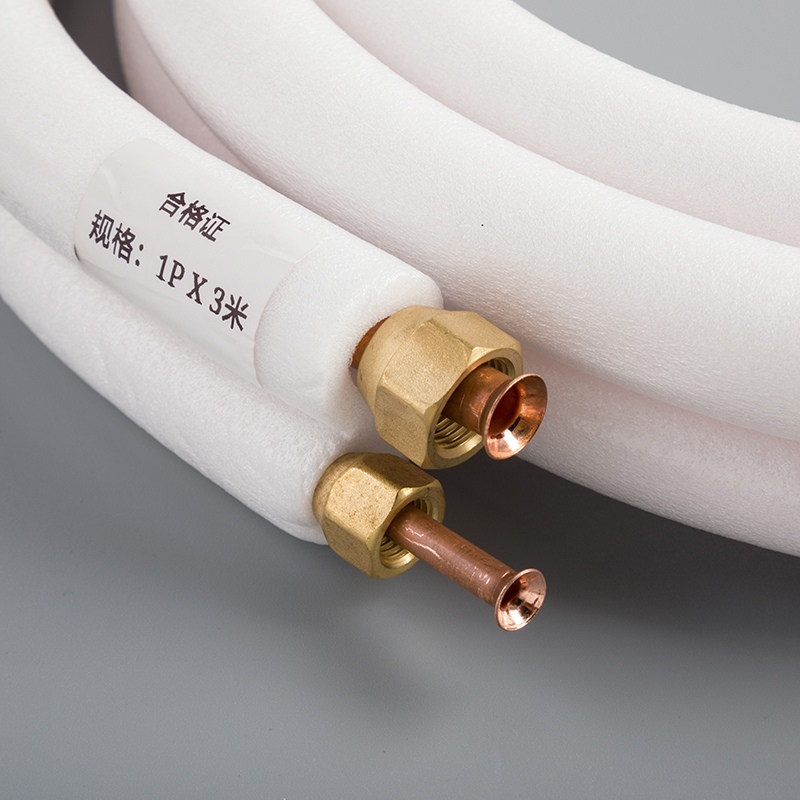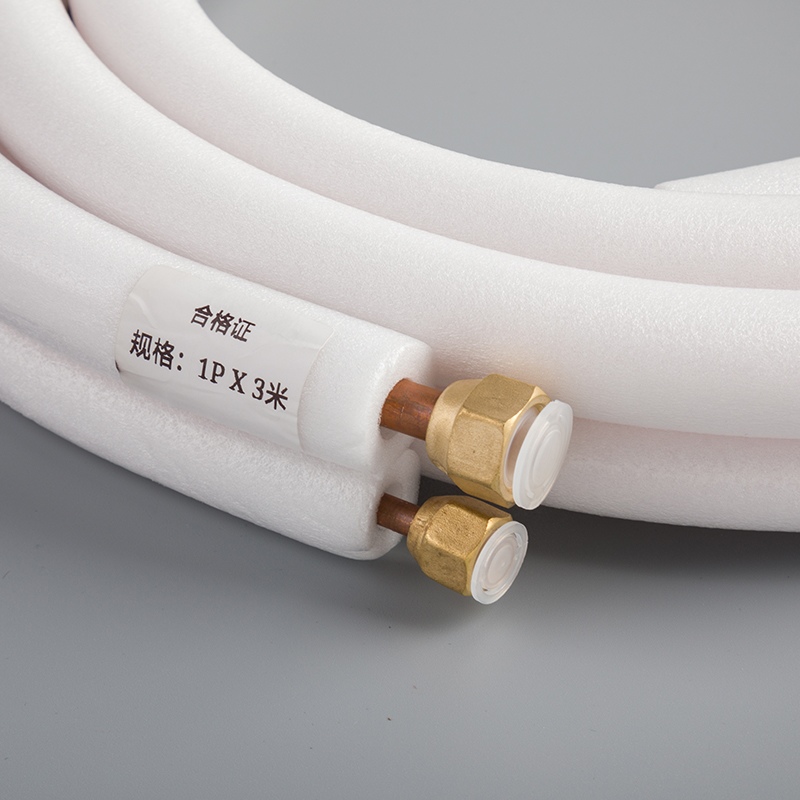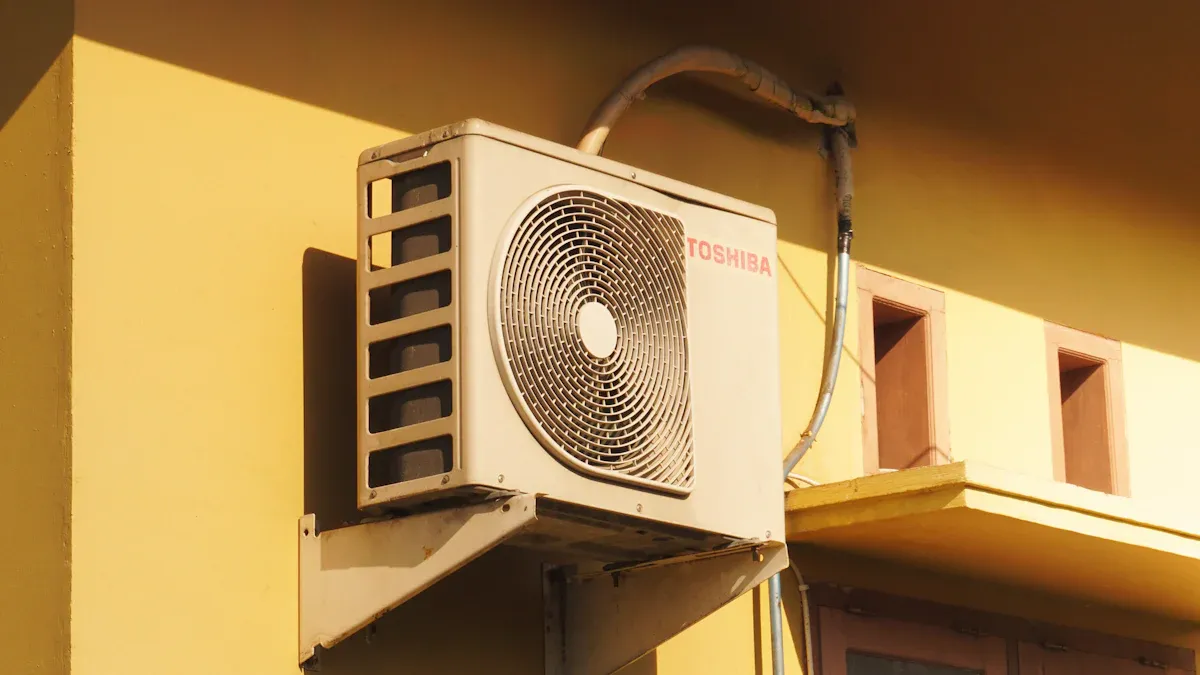Understanding Copper Pipe Types for Air Conditioning

When it comes to air conditioning systems, copper pipes are a game-changer. You might wonder why copper is the preferred material. It’s because copper pipes resist corrosion, ensuring they last for years while maintaining their durability. They’re also exceptional at conducting heat, which is essential for efficient cooling performance. If you’ve ever asked yourself what type of copper pipe is used for air conditioning, the answer lies in its ability to handle the demands of the system with ease. Additionally, copper’s flexibility simplifies installation, even in challenging setups. Curious about how long do copper AC lines last? With proper maintenance, they can serve you reliably for decades. And let’s not forget, copper is recyclable, making it a sustainable and eco-friendly choice.
Key Takeaways
Copper pipes do not rust, so they last a long time.
Type K pipes work well for high pressure, while Type L pipes are strong and affordable for homes.
Type M pipes cost less but are good for low pressure; pick based on your system's needs.
Taking care of and checking your copper pipes often can make them last much longer.
Copper can be reused, making it good for the environment and saving energy in your AC system.
Overview of Copper Pipes
Characteristics of Copper Pipes
Durability and Longevity
Copper pipes are built to last. Their natural resistance to corrosion means they can handle exposure to moisture and refrigerants without breaking down. Unlike plastic pipes, which can crack under pressure or temperature changes, copper pipes stay strong and reliable. This durability reduces the need for frequent repairs, saving you time and money in the long run.
Another reason copper pipes stand out is their ability to maintain efficiency over time. They resist oxidation, which helps protect your air conditioning system from leaks and toxic emissions. This makes them a dependable choice for both residential and commercial systems.
Thermal Conductivity
When it comes to transferring heat, copper is a superstar. Its high thermal conductivity ensures efficient cooling and heating in your air conditioning system. This means your system doesn’t have to work as hard, which can lower energy costs.
Take a look at some of copper’s key characteristics:
Characteristic | Description |
|---|---|
Electrical Conductivity | Excellent, second only to silver, widely used for electrical components. |
Thermal Conductivity | Very good, used in heat exchangers like condensers. |
Corrosion Resistance | High, particularly in water and seawater, ideal for plumbing applications. |
Ductility | High, can be bent easily, making it versatile for various applications. |
These properties make copper pipes a top choice for air conditioning systems, where efficient heat transfer is essential.
Advantages of Using Copper Pipes
Corrosion Resistance
Copper pipes excel at resisting corrosion, which is a game-changer for air conditioning systems. Here’s how this benefits you:
They reduce the risk of leaks, keeping your system running smoothly.
Their durability means fewer maintenance headaches.
Copper’s resistance to oxidation ensures efficient heat transfer and protects your system from moisture damage.
This level of reliability is hard to beat, especially when compared to other materials like plastic.
Flexibility and Ease of Installation
Installing copper pipes is a breeze. Their high ductility allows them to bend easily, making them perfect for tight spaces or complex layouts. You don’t need to worry about cracking or breaking during installation. Plus, copper pipes can be brazed, which creates strong, leak-proof joints.
This flexibility not only simplifies the installation process but also makes future repairs or adjustments much easier. Whether you’re working on a new system or upgrading an old one, copper pipes offer unmatched convenience.
Types of Copper Pipes for Air Conditioning

Type K Copper Pipes
Features and Applications
Type K copper pipes are the heavyweights of the copper pipe world. They’re known for their:
Excellent thermal conductivity, which ensures efficient heat transfer.
Superior corrosion resistance, making them reliable and long-lasting.
Strength and durability to handle high pressure and temperature changes.
Compatibility with various HVAC components.
Ability to reduce noise and vibration, creating a quieter environment.
These pipes are perfect for air conditioning systems that demand top-notch performance. Their ability to transfer heat efficiently means your system can adjust temperatures faster, saving energy and lowering costs. Plus, their resistance to corrosion ensures your AC system stays reliable for years.
Pros and Cons
Pros:
Extremely durable and long-lasting.
Ideal for high-pressure applications.
Excellent for reducing noise in HVAC systems.
Cons:
Higher cost compared to other types.
Less flexible, making installation more challenging in tight spaces.
Type L Copper Pipes
Features and Applications
Type L copper pipes strike a balance between durability and cost. Here’s what makes them stand out:
Feature | Description |
|---|---|
Wall Thickness | Moderately thick, suitable for high-pressure applications. |
Copper Grade | Higher grade than Type M, offering strength and reliability. |
Corrosion Resistance | Excellent resistance to refrigerants and chemicals. |
Applications | Commonly used in refrigeration and air conditioning systems. |
These pipes are versatile and work well in both residential and commercial HVAC systems. They’re also easier to install due to their moderate thickness, making them a popular choice for many applications.
Pros and Cons
Pros:
Cost-effective compared to Type K pipes.
Easier to install due to moderate wall thickness.
Suitable for a wide range of applications, including HVAC and gas lines.
Cons:
Slightly less durable than Type K pipes.
May not be ideal for extremely high-pressure systems.
Type M Copper Pipes
Features and Applications
Type M copper pipes are the most affordable option among the three. They’re lightweight and have thinner walls, which makes them suitable for low-pressure applications. These pipes are often used in residential air conditioning systems where the demands aren’t as intense as in commercial setups.
Pros and Cons
Pros:
Budget-friendly, making them a great choice for cost-conscious projects.
Lightweight and easy to handle during installation.
Cons:
Not suitable for high-pressure or heavy-duty applications.
Less durable compared to Type K and Type L pipes.
What Type of Copper Pipe is Used for Air Conditioning?
Preferred Choices for Different Systems
Residential vs. Commercial Applications
When choosing copper pipes for air conditioning, the type of system—residential or commercial—plays a big role. For residential systems, Type L copper pipes are the most common choice. They’re versatile and available in both rigid and flexible forms, making them easy to work with. Their moderately thick walls provide the durability needed for home air conditioning systems without being overly expensive. Plus, they handle the pressure and refrigerants used in residential setups effectively.
In commercial systems, the demands are higher. These setups often require pipes that can withstand greater pressure and more extreme conditions. Type K copper pipes are frequently used in these cases. Their thicker walls make them ideal for high-pressure applications and outdoor or underground installations. However, some commercial systems may also use Type L pipes when the pressure requirements are moderate, offering a balance between cost and performance.
Factors Influencing Choice
Several factors determine what type of copper pipe is used for air conditioning in different systems:
Pressure Requirements: High-pressure systems need thicker pipes like Type K or L, while low-pressure systems can use Type M.
Installation Environment: Outdoor or underground installations benefit from the durability of Type K pipes. For indoor use, Type L or M pipes are more practical.
Budget: Type K pipes are the most durable but also the most expensive. Type L offers a middle-ground option, while Type M is the most affordable but less durable.
Ease of Installation: Thicker pipes like Type K are heavier and harder to install. Thinner pipes, such as Type M, are easier to handle but may require more frequent replacements.
By considering these factors, you can choose the right pipe for your air conditioning system, ensuring efficiency and longevity. After all, why copper? It’s because it offers unmatched reliability and performance for both residential and commercial applications.
Comparison of Copper Pipe Types
Differences in Wall Thickness
Impact on Durability
When it comes to durability, wall thickness plays a huge role. Thicker walls make copper pipes more resistant to pressure, reducing the chances of leaks or cracks. For example:
Type K pipes, with a wall thickness of 0.049 inches for a ½-inch diameter, are the most robust. They’re perfect for high-pressure systems and underground installations.
Type L pipes, slightly thinner at 0.040 inches for the same diameter, still offer excellent durability. They’re a reliable choice for most residential and commercial air conditioning systems.
Type M pipes, with the thinnest walls at 0.028 inches for a ½-inch diameter, are best suited for low-pressure applications.
Thicker pipes like Type K and L can handle more stress, making them ideal for demanding environments. On the other hand, Type M pipes, while affordable, may require more frequent replacements due to their thinner walls. If you’re looking for long-term reliability, opting for thicker pipes is a smart move.
Suitability for Different Applications
Each type of copper pipe has its sweet spot. Type K pipes shine in heavy-duty applications, such as commercial systems or outdoor installations, where durability is critical. Type L pipes are versatile and work well in both residential and commercial setups. They’re a go-to option for most HVAC professionals. Type M pipes, with their lightweight design, are great for standard residential systems where pressure demands are lower.
If you’re unsure which to choose, think about your system’s pressure requirements and where the pipes will be installed. For high-pressure or outdoor use, go with Type K. For everyday residential needs, Type L or M will do the job.
Cost Considerations
Price Differences
Cost is another factor you’ll want to weigh. Here’s a quick breakdown:
Type | Cost Implication | Characteristics |
|---|---|---|
Type K | More expensive due to thickness | Highest durability and pressure resistance |
Type L | Good balance of cost and performance | Suitable for most residential/commercial systems |
Type M | Most affordable | Limited applications, cost-effective for low-pressure uses |
If you’re working on a tight budget, Type M pipes are the most affordable. However, keep in mind that their thinner walls might lead to higher maintenance costs down the line. Type L pipes strike a balance between cost and performance, making them a popular choice for most homeowners. Type K pipes, while pricier, offer unmatched durability and are worth the investment for high-pressure systems.
Long-term Value
You might save money upfront with Type M pipes, but they often require more maintenance and replacements. Type L pipes, with their moderate thickness, offer a great mix of durability and affordability, making them a long-term favorite for residential systems. Type K pipes, though the most expensive, deliver the best value for commercial setups where durability is non-negotiable.
Choosing the right pipe isn’t just about the initial cost. Think about how much you’ll save on repairs and replacements over time. Investing in a durable option now can save you headaches—and money—later.
Practical Applications in Air Conditioning

Residential Air Conditioning Systems
Commonly Used Pipe Types
In residential air conditioning systems, Type L and Type M copper pipes are the most common choices. Type L pipes are popular because they balance durability and cost. They work well in most home setups, handling refrigerants and moderate pressure effectively. Type M pipes, on the other hand, are a budget-friendly option. They’re lightweight and easy to install, making them ideal for systems with lower pressure demands.
If you’re installing a new system or replacing old pipes, you’ll likely encounter these two types. Their availability and versatility make them a go-to choice for homeowners and HVAC professionals alike.
Installation Considerations
Installing copper pipes in residential systems requires careful planning. Here’s a step-by-step guide to help you understand the process:
Inspect the installation environment. Make sure it meets the bending radius requirements to avoid damaging the pipes.
Gather the right tools, such as a pipe bender and flaring tool, to ensure precise cuts and bends.
Cut and bend the pipes as needed. Then, connect them using welding or flaring techniques for a secure fit.
Tip: Proper insulation is crucial. Choose materials with good thermal resistance and ensure a snug fit without compressing the insulation. Poor insulation can lead to energy loss and reduced efficiency.
Commercial Air Conditioning Systems
Commonly Used Pipe Types
Commercial systems often demand more robust materials. Type K copper pipes are the preferred choice due to their thicker walls and ability to handle high pressure. These pipes are perfect for large-scale systems and outdoor installations. In some cases, Type L pipes are also used when the pressure requirements are moderate.
The durability of these pipes ensures they can withstand the rigorous demands of commercial environments, making them a reliable option for businesses.
Installation Considerations
Installing copper pipes in commercial systems involves additional challenges. The pipes must handle higher pressures and longer distances. Here are some key considerations:
Use Type K pipes for underground or outdoor installations to ensure durability.
Ensure all joints are brazed securely to prevent leaks under high pressure.
Plan the layout carefully to minimize bends and reduce the risk of pressure drops.
Note: Commercial systems often require professional installation due to their complexity. Hiring an experienced technician ensures the job is done right and your system operates efficiently.
Addressing Common Concerns
How Long Do Copper AC Lines Last?
Factors Affecting Lifespan
You might wonder how long copper AC lines can last. The answer depends on several factors. On average, copper pipes can last anywhere from 40 to 80 years, depending on their type and usage. Here's a quick breakdown:
Pipe Type | Average Lifespan | Factors Affecting Lifespan |
|---|---|---|
Type K | 70-80 years | Less prone to corrosion, ideal for underground use |
Type L | 50-70 years | Balanced durability and cost, common in homes |
Type M | 40-60 years | Thinner walls, better for indoor use |
Several factors can influence this lifespan:
Water Quality: Hard water can cause scaling, while acidic water may lead to corrosion.
Installation: Proper techniques prevent premature failures.
Water Pressure: High pressure stresses pipes, increasing the risk of leaks.
Climate: Extreme temperatures can cause expansion or freezing, damaging the pipes.
Maintenance: Regular inspections and upkeep can extend the life of your copper AC lines.
By addressing these factors, you can ensure your copper pipes last as long as possible.
Maintenance Tips
Taking care of your copper AC lines is easier than you think. Regular maintenance can help you avoid costly repairs. Start by inspecting the pipes for signs of wear, such as discoloration or leaks. If you notice any issues, address them immediately.
Keep the water pressure in check to prevent unnecessary stress on the pipes. You can also install water softeners to reduce scaling caused by hard water. Finally, schedule professional inspections every few years to catch potential problems early. With these simple steps, you can maximize the lifespan of your copper AC lines.
Environmental Impact
Recyclability of Copper
Copper is one of the most recyclable materials on the planet. When your copper pipes reach the end of their life, they don’t have to go to waste. Instead, they can be recycled repeatedly without losing quality. In fact, about 50% of Europe’s copper demand is met through recycled materials.
Recycling copper pipes not only reduces waste but also conserves natural resources. Most scrap merchants accept old copper pipes, ensuring they’re repurposed rather than discarded. So, when you choose copper for your air conditioning system, you’re making an eco-friendly choice.
Energy Efficiency Benefits
Copper pipes also contribute to energy efficiency. Their excellent thermal conductivity minimizes heat loss, allowing your air conditioning system to work more efficiently. Proper insulation further enhances this benefit by reducing thermal exchange.
This efficiency translates to lower electricity bills and less strain on your AC system during peak usage. By choosing copper, you’re not just saving money—you’re also reducing your carbon footprint. That’s why copper remains a top choice for environmentally conscious homeowners.
Choosing the right copper pipe for your air conditioning system is crucial. It ensures efficiency, durability, and long-term value. Copper pipes stand out because they resist corrosion, transfer heat efficiently, and are easy to install. Plus, they’re recyclable, making them a sustainable choice.
Here’s a quick recap to help you decide:
Type K: Best for high-pressure or underground installations.
Type L: A versatile option for most residential and commercial systems.
Type M: Budget-friendly for low-pressure applications.
Remember, the right pipe type depends on your system’s pressure needs, installation environment, and budget. By choosing copper, you’re investing in reliability and energy efficiency for years to come.
FAQ
What is the best type of copper pipe for residential air conditioning?
Type L copper pipes are the most popular choice for residential systems. They offer a great balance of durability and cost. Their moderate wall thickness makes them reliable for handling refrigerants and pressure in home setups. Plus, they’re easier to install than thicker Type K pipes.
Can I use Type M copper pipes for my air conditioning system?
Yes, but only for low-pressure systems. Type M pipes are lightweight and affordable, making them suitable for budget-friendly residential projects. However, they’re less durable than Type L or K pipes. If your system has higher pressure demands, Type L or K would be a better choice.
How do I know if my copper pipes need replacing?
Look for signs like leaks, discoloration, or reduced cooling efficiency. If your pipes are over 40 years old, they might be nearing the end of their lifespan. Regular inspections can help you catch issues early and avoid costly repairs or replacements.
Are copper pipes environmentally friendly?
Absolutely! Copper is 100% recyclable and can be reused without losing quality. When you choose copper pipes, you’re making a sustainable choice. Plus, their energy efficiency reduces your carbon footprint, making them an eco-friendly option for air conditioning systems.
Do copper pipes require special maintenance?
Not really. Regular inspections for leaks or corrosion are enough to keep them in good shape. If you live in an area with hard water, consider using a water softener to prevent scaling. Proper insulation also helps maintain efficiency and extends the lifespan of your pipes.
See Also
The Benefits of Using Copper Pipes in AC Systems
Transforming Air Conditioning with High-Quality Copper Pipes
The Essential Role of Copper Pipes in AC Efficiency


